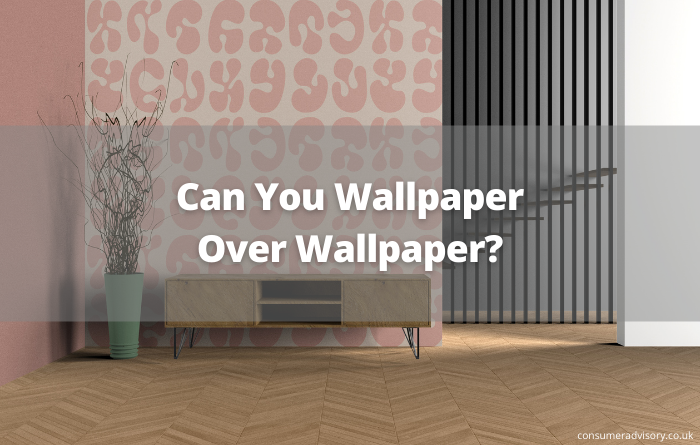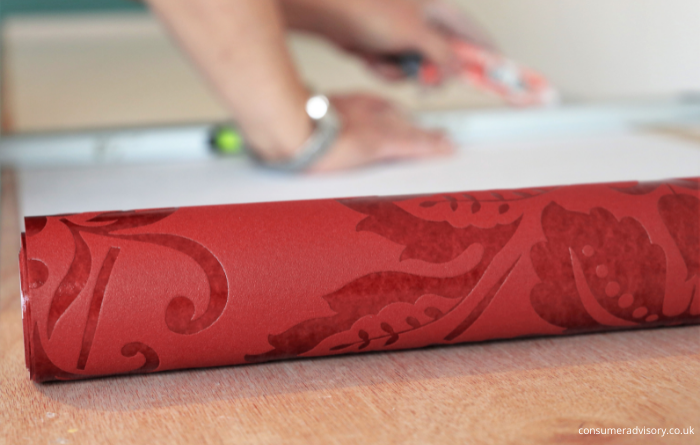
If you are looking for a way to change the look of your room without painting, you may be wondering ‘can you wallpaper over wallpaper?’. The answer is yes, you can wallpaper over wallpaper, but there are some things you need to keep in mind.
In this article, we’ll tell you everything you need to know about wallpapering over existing wallpaper, including everything you need to consider before making the decision to do so.
How Can I Cover Wallpaper Without Removing It?
If you want to cover wallpaper without removing it, you can use a technique called ‘wallpapering over’. This is where you apply a new layer of wallpaper on top of the old wallpaper.
There are a few things to keep in mind if you want to try this technique:
- The two wallpapers must be compatible – meaning that they are the same type of wallpaper (e.g. both vinyl or both paper) and have the same level of durability.
- Make sure that the new wallpaper is at least as durable as the old wallpaper, if not more so.
- The two wallpapers must be the same size – otherwise, you may have trouble with the edges and may need to cut and fit them yourself.
Removing Wallpaper
If you choose not to wallpaper over your old wallpaper, or if your wallpapering ‘project’ fails, you will probably want to remove the old paper by stripping it off the walls. This is a time consuming job that usually involves scraping away as much of the old paper as possible, and then using a wallpaper remover to get rid of any leftover adhesive.
It is usually a good idea to start by removing the wallpaper in one corner of the room so that you can see how it is done before attempting to remove it from the entire room.

Putting Wallpaper Over Old Wallpaper
If you decide to hang new wallpaper over your existing wallpaper, the first thing you need to do is make sure that the existing wallpaper is in good condition. If there are any cracks, bumps or tears in the paper, it will show through the new wallpaper. If the old wallpaper is peeling or bubbling, it needs to be removed before you start wallpapering over it.
If the wallpaper is not in good condition, you will need to remove it. This process will depend on the type of wallpaper you have and how easily it comes off, but a good way to start is with a steamer. If this doesn’t work, try wetting the paper with warm water and peeling it off with your hands – just be sure to wear rubber gloves as this can be very messy and very difficult work.
If your wallpaper is in good condition, you may decide to hang your new wallpaper over your existing wallpaper. This is a great way to save money, and it removes the effort of removing the old paper before hanging the new.
Putting The New Wallpaper Over the Old
The first step in wallpapering over wallpaper is preparing your room for new wallpaper. This means removing anything that can be removed from your walls, such as switch and outlet covers, pictures and shelves. Once everything is off the walls, clean them thoroughly. This removes any dirt and grease so the new wallpaper will attach well to your wall.
Once you have prepared your room for hanging wallpaper, you need to figure out what type of wallpaper you are going to use. Different types of wallpaper have different properties, so knowing the type of paper you are using will help you prepare your walls. If you are unsure of what your wallpaper is made from or how it should be hung, ask a professional at the store where you purchase your wallpaper for assistance.
Once the new paper is ready to hang, follow the instructions on the package. Most papers come with a set of instructions that tell you how to hang the paper and what type of adhesive to use. Be sure to read these instructions carefully before starting to avoid any problems.
Do You Have To Use Backing Paper Before Wallpapering?
Some people choose to hang backing paper on their walls before wallpapering. This helps to protect the walls from the adhesive on the new wallpaper, and it makes the process of wallpapering easier. If you choose to use backing paper, be sure to purchase a type that is compatible with your new wallpaper.
If you are not using backing paper, you will need to make sure that the surface of your walls is smooth and free of bumps or ridges. Hanging wallpaper over a bumpy surface is difficult, and you may need to sand your walls before hanging the new paper.

Disadvantages Of Wallpapering Over Existing Wallpaper
Wallpapering over wallpaper can be a great way to change the look of your room without spending time removing the existing wallpaper, but it does have some disadvantages.
If the old wallpaper is not in good condition, wallpapering over it could cause problems with the new paper because of the different properties between old and new papers. Water can also become trapped behind two layers of wallpaper, causing bubbles to form when covered by paint or other decorations.
If you are using wallpaper that comes on a roll, you may not be able to line up the pattern perfectly when hanging it. This can cause some areas to have mismatched patterns or gaps in the paper where the old wallpaper shows through underneath.
If you are using wallpapering paste, adding too much water could make the wallpaper swell and bubbles could form under the new paper. If this happens, you will need to remove the wallpaper and repaste it before continuing on with the project.
If your old wallpaper is peeling or bubbling, do not try to wallpapering over it because water and other materials could get trapped inside the new paper and cause problems later down the line. In this case, it is always best to remove the existing wallpaper before hanging the new paper.
Wallpapering over wallpaper can be a great way to save time and money, but it is important to be aware of the potential problems that could occur. By taking the time to read the instructions and preparing your room properly, you can avoid any nasty surprises down the road.
How Many Layers Of Wallpaper Can I Put On A Wall?
You can put as many layers of wallpaper on a wall as you want, but be aware that adding too many layers could cause problems, as the wall will struggle to breathe through the paper.
Two or three layers of wallpaper is the most you should hang on a wall. If you are planning on putting a lot of paper up, it is always best to ask a professional for advice.

Is It Better To Remove Or Paint Over Wallpaper?
Before you decide if it’s better to remove or paint over wallpaper, you need to ask yourself a few questions.
- How much time are you willing to spend on this project?
- How much money are you willing to spend?
- Is the wallpaper in good condition?
If you are looking to complete your project quickly and on a tight budget, and your existing wallpaper is in good condition, painting over the wallpaper may be a good option. However, it’s important to remember that it’s likely that you will still see the seams of the wallpaper through the paint.
However, if you have a larger budget and time to spend on the project, you will achieve a smoother and more professional finish by removing the wallpaper and properly preparing the wall for painting.
Spilt gloss paint on your carpet? Find out how to remove it here
How Do You Hide Seams When Painting Over Wallpaper?
If you choose to paint over wallpaper, one way to hide the seams between the sheets of paper is to use a color that is similar to the surrounding wall. This will help to camouflage the seams and make them less noticeable.
Another way to hide seams when painting over wallpaper is to use a primer before painting. A primer will fill in any gaps between the sheets of wallpaper and will help the paint to stick better, making the seams less noticeable.
Removing wallpaper is a more time-consuming project, but it will give you a much smoother finish than if you were to paint over it. By properly preparing the wall and using the right type of paint, you can hide the seams between sheets of wallpaper and achieve a seamless look.
In Summary
Wallpapering over wallpaper can be a great way to save time and money, but it is important to be aware of the potential problems that could occur. By taking the time to read the instructions and preparing your room properly, you can avoid any nasty surprises down the road. If you are considering wallpapering over wallpaper, ask yourself the questions above to help you make the best decision for your project.
In this article, we have answered the question ‘can you wallpaper over wallpaper?’, as well as weighing up your options when it comes to redecorating a wallpapered room.
